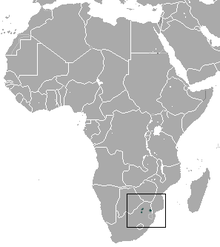Juliana's golden mole
| Juliana’s golden mole | |
|---|---|
| Scientific classification | |
| Kingdom: | Animalia |
| Phylum: | Chordata |
| Class: | Mammalia |
| Order: | Afrosoricida |
| Family: | Chrysochloridae |
| Genus: | Neamblysomus |
| Species: | N. julianae |
| Binomial name | |
| Neamblysomus julianae (Meester, 1972) | |
 | |
| Juliana's golden mole range | |
| Synonyms | |
|
Amblysomus julianae | |
Juliana’s golden mole (Neamblysomus julianae) is a golden mole endemic to South Africa. It is listed as an endangered species due to habitat loss and a restricted range. Golden moles are an ancient group of mammals that live mostly below ground.
Description
They have shiny coats of dense fur and a streamlined, formless appearance. They have no visible eyes or ears; in fact, they are blind - the small eyes are covered with hairy skin. The ears are small and are hidden in the animal's fur. Juliana's golden mole weighs 21–75 g (0.75–2.7 oz).[2]
Ecology
It is confined to sandy soils, often pockets along weathered rocky ridges of quartzite or granite. It is also common in well-irrigated gardens. Usually two young are born, sometimes one. Golden moles eat invertebrates such as insects, earthworms and snails. Their young are born in a grass-lined cavity in the ground. Golden moles usually dig their tunnels just below the surface of the ground. The main feeding activity is in the late afternoon and at night. They exhibit torpor daily during the morning and early afternoon.[2]
Status
Juliana’s golden mole is found in Pretoria (Gauteng), Nylstroom (Limpopo Province) and Kruger National Park (Mpumalanga), South Africa. Where it occurs, Juliana’s golden mole can be locally common. However, its occurrence is extremely patchy within its limited geographic range. There are no data on population size. The population on Bronberg Ridge, Pretoria East, is severely affected by ongoing intensive urbanization and a mining operation, and it is considered to be critically endangered. The Nylsvley population in Limpopo occurs in farmlands (adjoining the Nylsvley Nature Reserve) that are subject to habitat alteration and potential degradation. Another threat is habitat fragmentation which causes obstruction to animal movement; this results in in-breeding which increases the possible risk of extinction. The International Union for Conservation of Nature now rates this species as "endangered".[1]
References
- 1 2 Maree, S. (2015). "Neamblysomus julianae". IUCN Red List of Threatened Species. Version 2008. International Union for Conservation of Nature. Retrieved 1 November 2016.
- 1 2 Jonathan Kingdon; David Happold; Thomas Butynski; Michael Hoffmann; Meredith Happold; Jan Kalina (2013). Mammals of Africa. A&C Black. pp. 256–257. ISBN 978-1-4081-8996-2.
- Bronner, G.N.; Jenkins, P.D. (2005). "Order Afrosoricida". In Wilson, D.E.; Reeder, D.M. Mammal Species of the World: A Taxonomic and Geographic Reference (3rd ed.). Johns Hopkins University Press. p. 81. ISBN 978-0-8018-8221-0. OCLC 62265494.
